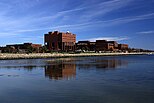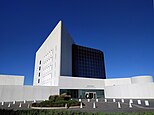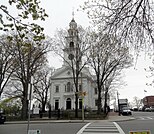
Back دورچزتر، بوزتون AZB Dorchester (lungsod sa Tinipong Bansa, Massachusetts) CEB Dorchester (Boston) German Dorchester (Masaĉuseco) Esperanto دورچستر، بوستون Persian Dorchester (Boston) Finnish Dorchester (Boston) French Dorchester (Massachusetts) Frisian Dorchester (Massachusetts) Italian Dorchester (Boston) Polish
Dorchester, Boston | |
|---|---|
|
Left-right from top: University of Massachusetts Boston campus, Neponset River at Lower Mills , JFK Presidential Library, Lawrence Avenue Historic District, Edward Everett Square, First Parish Church of Dorchester | |
| Nickname: Dot | |
| Motto(s): Pietate, Literis, Industria (Latin) "Piety, Learning, [and] Industry" | |
| Coordinates: 42°19′N 71°3′W / 42.317°N 71.050°W | |
| Country | United States |
| State | Massachusetts |
| County | Suffolk |
| Neighborhood of | Boston |
| Settled | May 1630 |
| Incorporated | June 1, 1630 |
| Annexed by Boston | January 4, 1870[1] |
| Named for | Dorchester, Dorset |
| Population (2010)[2] | |
• Total | 91,982 to 134,000 |
| Time zone | UTC-5 (Eastern) |
| • Summer (DST) | UTC-4 (Eastern) |
| ZIP Codes | 02121, 02122, 02124, 02125, 02126 (part of 02126 includes the Dorchester Lower Mills section of Dorchester) |
| Area code(s) | 617 and 857 |
Dorchester (/ˈdɔːrtʃɛstər/) is a neighborhood comprising more than 6 square miles (16 km2) in the City of Boston, Massachusetts, United States. Originally, Dorchester was a separate town, founded by Puritans who emigrated in 1630 from Dorchester, Dorset, England, to the Massachusetts Bay Colony. This dissolved municipality, Boston's largest neighborhood by far,[3] is often divided by city planners in order to create two planning areas roughly equivalent in size and population to other Boston neighborhoods.
The neighborhood is named after the town of Dorchester in Dorset, from which Puritans emigrated to the New World on the ship Mary and John, among others.[4]
Founded in 1630, just a few months before the founding of the city of Boston, Dorchester now covers a geographic area approximately equivalent to nearby Cambridge.[5] When annexed to Boston in 1870, Dorchester was still a primarily rural town and had a population of 12,000. Construction of railroad and commuter streetcar lines brought rapid growth, increasing the population to 150,000 by 1920. In the 2010 United States Census, the neighborhood's population was 92,115.
The Dorchester neighborhood has a very diverse population, which includes a large concentration of African Americans, European Americans (particularly those of Irish, German, Italian, and Polish origin, reflecting late 19th and early 20th century immigration). More numerous immigrants and their descendants since the later 20th century have come from the Caribbean Caribbean, Central and South America, and East and Southeast Asian Americans.
Dorchester also has a significant LGBT population, with active political groups. It has the largest concentration of same-sex couples in Boston after the neighborhoods of South End and Jamaica Plain.[6] Most of the people over the age of 25 have completed high school or obtained a GED.[7]
- ^ "Dorchester MA, Town History 1630–1870" Archived 2013-10-20 at the Wayback Machine, Dorchester Atheneum
- ^ Bill Forry (2011). "Analysis: City counters bend boundaries, thousands cut out of Dot". Boston Neighborhood News, Inc. Retrieved April 13, 2011.
- ^ "Boston's Neighborhoods: Dorchester". Boston Redevelopment Authority (BRA). 2010. Retrieved August 17, 2010.
- ^ Clapp, Ebenezer. History of the Town of Dorchester, Massachusetts, Dorchester, Boston, MA: Dorchester Antiquarian and Historical Society, 1890.
- ^ History of Dorchester, Massachusetts Archived 2012-02-04 at the Wayback Machine
- ^ "Under a rainbow flag, linking the Dots – The Boston Globe". archive.boston.com. Retrieved 2017-08-11.
- ^ Cite error: The named reference
:0was invoked but never defined (see the help page).







